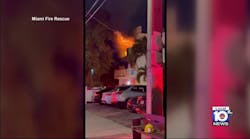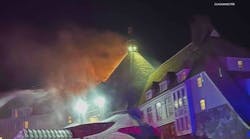Aug. 1, 1901: WHITE PLAINS, NY - A lightning strike tore through the roof of a Baptist church and started a fire in the Sunday school room. The discharge ripped through a wall and severed a gas line that ignited and fed a three-foot flame. The fire incinerated all of the wooden fixtures and reduced them to cinders. The gas-fed flame continued to burn until it was discovered the next day. The stained-glass windows never failed and a large oak door leading to the main church held back the flames.
Aug. 2, 1901: NEW YORK CITY - Two young boys were charged with turning in a false alarm and were brought before Magistrate Mayo. The lads and their father, in from Philadelphia to attend a funeral, stood before the indulgent judge, who remarked, "Philadelphia is a dead town, and boys from there can hardly be blamed for doing rash things when they come to this city and get imbued with life. But don't you ever do that again or I'll send you up for life!"
Aug. 3, 1901: HOBOKEN, NJ - While the freighter Helen F. Roberts was being unloaded at the Hamburg-American docks, fire was discovered among bales of cotton. The vessel was towed into the river and surrounded by fireboats and tugboats and was deluged with water. The freighter was then beached on the Weehawken flats.
Aug. 3, 1901: NEW YORK CITY - At about 11:30 P.M., flames were seen in the huge lumber yards on Bay Street in the Tompkinsville section of Staten Island and the volunteer fire department responded. Flames soon swept the three-block-long wood stores and threatened to extend. Mutual aid was requested and responded from other volunteer departments as well as fireboats from Manhattan. The fire was extinguished after a difficult hour-long battle.
Aug. 5, 1901:PHILADELPHIA - An explosion rocked a block of six buildings on Locust Street near Tenth Street, destroying five structures and claiming the lives of two people. It was estimated that as many as 35 people were in the buildings when the blast occurred in a barrel of gasoline in a grocery store at about 9:30 P.M. Windows were blown out for a two-block radius and fire was jumping the street as firemen arrived. Numerous people were dragged to safety by the firemen as the wall of flames grew. Hoselines were pushed in and the fire was contained quickly. It was believed that several victims were buried in the rubble.
Aug. 7, 1901: LAUREL, DE - A fire was discovered shortly after midnight in the Riggen & Son's Carriage Factory. E.B. Riggen, son of a former speaker of the House of Representatives of Delaware, dashed into the building and was apparently stricken with an epileptic seizure and collapsed on the second floor, where he was burned to death.
Aug. 8, 1901: PERTH AMBOY, NJ - One man was killed and three were injured when a vat filled with creosote exploded in the American Wood Preserving Company. The 60-by-eight-foot vat was filled with wood to be preserved when then explosion tore off a large door at one end and decapitated a worker standing nearby. Three others were severely injured.
Aug. 8, 1901: NEW YORK CITY - Two small fires were extinguished onboard the White Star liner Majestic. The ship's fire brigade was able to quickly douse both fires, which broke out in a linen closet. It was believed that the fires were the result of defects in the boiler room directly below. The ship had just arrived in the city after a trans-Atlantic voyage from Liverpool, England.
Aug. 8, 1901: NEW YORK CITY - The members of Engine 39 and Ladder 16 were in mourning after their mascot, a foxhound, was killed in the line of duty. The dog slipped off the pumper during a response to a fire on East 78th Street and was run over by the tender. The dog, a gift from a banker, was worth more than $1,000 and had become a fixture in the firehouse.
Aug. 11, 1901: PARIS - One of France's largest absinthe (a green, bitter liqueur) factories was struck by lightning and caught fire during a violent storm. Within several minutes a number of large buildings were ablaze as were the huge stores of spirits in the cellars. A stream of burning alcohol was soon pouring into the river, causing firemen even more problems.
Aug. 11, 1901: JERSEY CITY, NJ - Fire raced through the Weldon Building, a five-story office structure at 70 Montgomery St. The top three floors were quickly in flames and more than 20 rooms, including Western Union telegraph, a law library and factory offices, were destroyed.
Time Capsule
CLEVELAND, AUG. 14, 1901: DEADLY FIRE AT TUNNEL PROJECT
Five men were burned to death, four were drowned and possibly two more were suffocated by a fire that destroyed a temporary waterworks crib two miles off Cleveland Harbor. Many workers were sleeping in their bunks as others toiled in the tunnel 200 feet below the lake when the flames broke out. An overheated boiler caused a fire in the surrounding woodwork, then exploded tearing through the crib's pine planking.
The men in their bunks were cut off from escape by fire as the workers below continued to dig, unaware of the holocaust above until their air supply was cut off. Fireboats and tugboats raced to the scene and drove powerful streams of water into the flames and pulled naked burned and injured men from the water.
After an hour, firemen were able to advance handlines into the burning structures. As the fire was knocked down, a rescue attempt was devised to reach those trapped below in the tunnel. Seven men were pulled up by rope from the dark shaft. The next day, an engineer entering the shaft to survey and search for survivors was overcome by gas and died. Two men were dug out alive five days after the initial explosion and fire.
Seven days later, another explosion took the lives of five more workers and injured an additional 30. A coroner's inquest placed the blame on the City of Cleveland, the subcontractor and the crib engineer for improper safety procedures and inspections.
Compiled by Paul Hashagen




